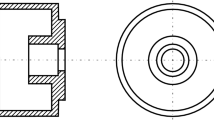Abstract
Block brakes have been used to brake railway vehicles for approximately 200 years. During the last 40 years, disk brakes have replaced the block brakes at passenger cars but block brakes are still used for all freight wagons. One problem of block brakes is that they show an enormous tendency to squeal. Although the block brake is a very common and old technical component, there exists almost no scientific work on its noise behavior regarding squeal. On the other hand, a lot of work has been done on the problem of disk brake squeal especially concerning the modeling of the excitation mechanism. The goal of this paper is to investigate whether and how models from disk brake squeal can be modified to model block brake squeal. The starting point of these investigations is a minimal model for an automotive disk brake introduced by von Wagner et al. (J Sound Vibration, 51(1–2):223–237, 2007) that is adapted to the block brake problem. It can be shown that such a simple converted model does not show any instability at all. A deeper analysis suggests that the reasons for squeal in block brakes could originate from in-plane vibrations of the brake disk or specific geometrical properties of the railway wheel. The self-excited vibrations explaining the squeal occur at relatively low rotational speeds far below the first critical rotor speed which has rarely been observed in rotor dynamics.
Similar content being viewed by others
References
Becker-Lindhorst, K.: Dissq disc supressing squeal, Quietschfreie Hochleistungsscheibenbremse. Leiser Verkehr, Lärmforschung im Forschungsprogramm Mobilität und Verkehr, Bundesministerium für Bildung und Forschung (2003)
Beier, M.: Disc supressing squeal (dissq); squealing free high performance disk brake. Euronoise Tampere (2006)
Bühler, S.: Eurosabot field measurement–methods and results. J. Accoust. Soc. Am. 105 (1999)
Ehlers, H.R.: Potenziale und Grenzen der Klotzbremse im Vergleich zur Scheibenbremse. ZEVrail Glasers Annalen, pp 126–617 (2002)
Gasch R., Nordmann R., Pfützner H.: Rotordynamik. Springer, Berlin (2002)
Hagedorn P.: Non-Linear Oscillations. Calendron Press, Oxford (1988)
Hochlenert D., Spelsberg-Korspeter G., Hagedorn P.: Friction induced vibrations in moving continua and their application to brake squeal. Trans. ASME J. Appl. Mech. 74, 542–549 (2007)
Hoffmann N., Fischer M., Allgaier R., Gaul L.: A minimal model for studying properties of the mode-coupling type instability in friction induced oscillations. Mech. Res. Commun. 29, 197–205 (2002)
Ibrahim R.A.: Friction-induced vibration, chatter, squeal and chaos, part i: mechanics of contact and friction. ASME Appl. Mech. Rev. 47(7), 227–253 (1994)
Karapetjan A.V.: The stability of nonconservative systems. Vestnik Moskovskogo Universiteta Serija 1, mathematika, mechanika 4(30), 109–113 (1975)
Kinkaid N.M., O’Reilly O.M., Papadopoulos P.: Automotive disc brake squeal. J. Sound Vibration 267, 105–166 (2003)
Krettek O., Abdel U., Zobory I.: Modellierung der Klotzbremse. ZEV+DET Glas 1, 18 (1994)
Lakhadanov V.M.: On stabilization of potential systems. PMM 39(1), 53–58 (1975)
Lorang X., Foy-Margiocchi F., Nguyen Q., Gautier P.: TGV disc brake squeal. J. Sound Vibration 293, 735–746 (2006)
Mottershead J.: Vibration- and friction-induced instability in disks. Shock Vibration Dig. 30(1), 14–31 (1998)
Ouyang H., Mottershed J.E.: Dynamic instability of an elastic disk under the action of a rotating friction couple. J. Appl. Mech. 71, 753–758 (2004)
Ouyang H., Nack W., Yuan Y., Chen F.: Numerical analysis of automotive disc brake squeal: a review. Int. J. Vehicle Noise Vibration 1(3), 207–231 (2005)
Shin K., Brennan M., Oh J., Harris C.: Analysis of disc brake noise using a two-degree-of-freedom model. J. Sound Vibration 254(5), 837–848 (2002)
Spelsberg-Korspeter G.: Breaking of symmetries for stabilization of rotating continua in frictional contact. J. Sound Vibration 322, 798–807 (2009)
Spelsberg-Korspeter G., Hochlenert D., Kirillov O.N., Hagedorn P.: In- and out-of-plane vibrations of a rotating plate with frictional contact: Investigations on squeal phenomena. Trans. ASME J. Appl. Mech. 76(4), 041, 006/1–041,006/14 (2009)
Tross A.: Geteilter Bremsbelag, insbesondere für Schienenfahrzeuge. Deutsches Patentamt, Auslegeschrift 1170, 444 (1964)
von Wagner U., Schlagner S.: On the origin of disk brake squeal. Int. J. Vehicle Design 51(1–2), 223–237 (2009)
von Wagner U., Hochlenert D., Hagedorn P.: Minimal models for the explanation of disk brake squeal. J. Sound Vibration 302, 527–539 (2007)
Wiemers, M.: Einfluss von Steifigkeit und Dämpfung bei Eisenbahnrädern insbesondere von Güterwagenrädern auf die Schallabstrahlung. PhD thesis, TU Berlin (2005)
Zander, C.P.: Klotzbremsen mit Sintermetallbelägen. ZEV + DET Glas 125 (2001)
Author information
Authors and Affiliations
Corresponding author
Rights and permissions
About this article
Cite this article
von Wagner, U., Spelsberg-Korspeter, G. Minimal models for squealing of railway block brakes. Arch Appl Mech 81, 503–511 (2011). https://doi.org/10.1007/s00419-010-0422-y
Received:
Accepted:
Published:
Issue Date:
DOI: https://doi.org/10.1007/s00419-010-0422-y



